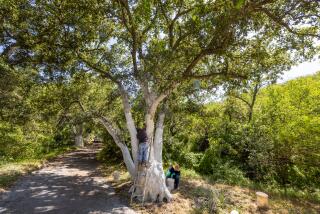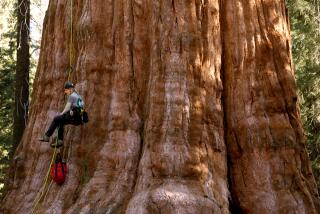Trees Along National Mall Facing Doom
- Share via
WASHINGTON — The National Mall in Washington is being altered forever by a little-known tree disease that is killing off hundreds of its oaks and elms.
Bacterial leaf scorch is slowly destroying century-old elm and oak trees at the mall by crippling their ability to drink up water, according to tree experts for the National Park Service.
Leaf scorch is believed to be spread by insects and to be a relative of the same disease that has devastated peach trees in Georgia, grapevines in California and coffee trees in Brazil over the last decade.
Scientists say it has now infected 180 elm trees on the mall and 37 of the red oak trees in Constitution Gardens, which is the landscaped area on the north side of the Reflecting Pool near the Lincoln Memorial.
“If you’re at all patriotic, it just breaks your heart to see this. I mean, the mall is one of our national symbols,” said Jo-Ann Bentz, who is studying the disease for the U.S. Department of Agriculture. “You get sort of emotional over this.”
Anyone who visited Washington for the National Cherry Blossom Festival probably did not notice any problems.
The chief symptom--a browning of the leaves--does not appear until July or August. And the cherry trees have escaped the infection.
National Park Service officials say leaf scorch also has infected scattered clusters of trees throughout the East Coast.
“It’s a major problem, and in many places it’s largely going undetected,” said James Sherald, a plant pathologist who is the natural resource specialist assigned by the National Park Service to the mall.
The disease, spread by leaf-hopping insects that Bentz is now studying, turns elm and oak leaves brown, attacks the tissues that spread water throughout the trees and slowly causes them to die of thirst, experts say.
Sherald said scientists are unsure how the insects transmit leaf scorch from tree to tree. They also have no idea how to cure it, and the only preventive measure they can recommend is to make sure diseased trees are removed.
But diagnosis is difficult. The symptoms for leaf scorch are similar to the symptoms for drought, a browning of the leaves, usually in July and August, that makes the tree look as if it is showing its autumn colors prematurely.
With leaf scorch, the leaves don’t fall from the tree, but hang on until autumn, Bentz said.
Afflicted young trees may last five years, while older trees may last for a decade, but no matter what age, the trees’ days are numbered, she said.
“When the tree is infected, forget it; it’s doomed,” Bentz said.
Sherald and other tree experts say leaf scorch also cripples a tree and makes it more susceptible to other diseases that can kill it in one or two years.
“Anything that weakens the tree makes it more attractive to these insects. It’s like cooking a steak for you or me and ringing a dinner bell,” said Marion Bedingfield, tree service technician for Baltimore’s Department of Recreation and Parks.
Sherald said he is concerned that the mall’s crippled trees will fall prey to Dutch elm disease or elm yellows, another disease believed to be spread by leafhoppers that turns elm leaves yellow and causes them to droop until they drop from the tree.
Dutch elm, which wiped out millions of elms throughout the country over the last 60 years, remains a problem, killing up to a dozen trees on the National Mall and another dozen around the capital’s national monuments, Sherald said.
Bentz, who works at the Floral and Nursery Plants Research Unit in Beltsville, Md., has collected 40,000 leafhoppers and spittlebugs from the mall trees since 1993 because they are believed to transmit the disease.
Using yellow plastic sheets that work like flypaper, she and a team of four people have collected insects from the trees by making weekly trips to the mall between April and November. By analyzing DNA taken from their tissues, she hopes to learn how the insects acquire and transmit the deadly bacterium, Xylella fastidiosa, as a first step toward finding a natural enemy in the insect world that can keep the bugs in check.
It could be five years before she has any answers, she said.
“I never thought I’d be looking at so many insects in my life,” she said, peering through a microscope at one of the spittlebugs.






